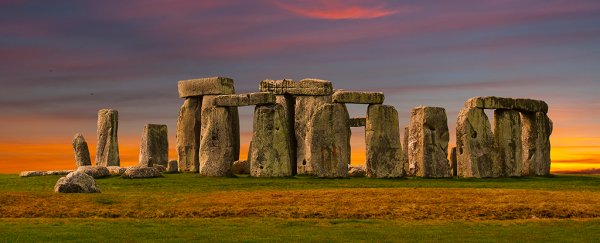If there's one thing the ancient mathematician Pythagoras of Samos is most famous for, it's a formula to work out the longest side of a right-angled triangle.
The pointy-bearded Greek might get the kudos, but the theorem has popped up independently throughout history, and across the globe. A new book adds another to the list – it was used in ancient Britain to build the famous monument Stonehenge.
The authors behind Megalith: Studies in Stone have used the geometry of the massive blocks making up the henge to suggest their creators knew a thing or two about the relationship between a hypotenuse and its opposing sides.
Most of us learn this as the Pythagorean theorem, which is spelled out as a^2 + b^2 = c^2, where a and b meet at a right angle and c makes up the triangle's long side.
This pattern is incredibly useful when you want to accurately determine distances between points in a right angled triangle or in quadrilaterals, whether it's for constructing monuments, mapping constellations, or dividing up land.
So it's little surprise that scholars have seen signs of its use among Babylonian, ancient Chinese, and Vedic Indian cultures.
The reason we slap Pythagoras's name on it is more an accident of history than anything.
The mathematician lived around the sixth century BCE, and later writers spoke of his mathematical proof of the theorem. Unfortunately, like a lot of writing from that period, first-hand accounts have been lost to time.
But there is a tradition we can trace from your grade 8 mathematics teacher through European, Islamic, Persian, and finally Greek schools and textbooks that attribute the formula and its proof to Pythagoras.
As for all of those other mathematicians who stumbled on this relationship, they either didn't impress anybody enough with a proof, or at that point there was nobody around singing their praises.
Hints can still be found, though, and according to reports, this new book argues such examples exist in the 4,500 year old arrangements of Stonehenge.
"We see triangles and double squares used which are simple versions of Pythagorean geometry," editor John Matineau told The Telegraph.
"And then we have this synthesis on different sites of solar and lunar numbers."
The authors claim the sides of the triangles form ratios that echo the famous formula, suggesting that even if they didn't have proofs, the builders knew it was a useful way to make a right-angled triangle.
Not only did they appear to build blocks using it, the site of Stonehenge itself is argued to form a Pythagorean triangle with the quarries where its giant stones originated.
Like Rome, Stonehenge wasn't built in a day. Its construction from mounds of dirt and ditches to a crown of tree trunks to a circle of stone took centuries, with that iconic ring of pillars going up roughly 2,500 BCE.
The materials themselves were imported from two sources, one of which was an island. This was clearly no Sunday afternoon affair; those who built it knew what they were doing, and took great care in the process.
The succession of developments were probably contributed to by different cultures, some less friendly than others.
The neolithic farmers responsible for putting up the stones didn't leave behind great records of mathematical discovery, but that's not to say they didn't have plenty of tricks up their sleeve.
Mind you, all of this should be read with a great deal of chin scratching. For one thing, it's a book, not a research paper that's passed peer review, so there's the caveat that we'd need to dig deeper to have a better informed opinion.
Numerical relationships hidden in structures and locations are a favourite topic for historians, and while they can indeed provide clear signs of knowledge and cultural development, they can also be figments of our own imagination.
With all of that in consideration, finding that such a useful mathematical formula was applied to a structure of such cultural significance can tell us more about how diverse cultures developed mathematical tools for construction, travel, or even fun.
Pythagoras might get all the glory, but it's important to remember he didn't have the market cornered on triangles.
